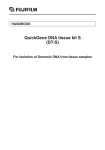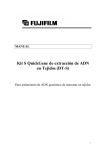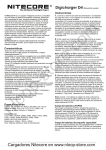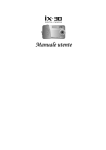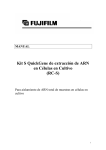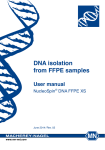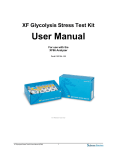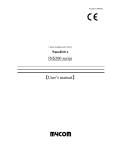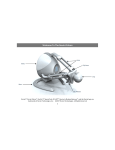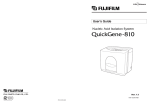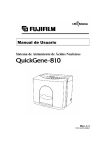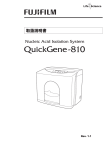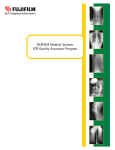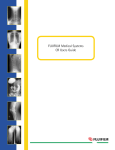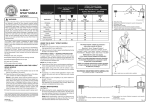Download QuickGene RNA tissue kit S (RT-S)
Transcript
HANDBOOK QuickGene RNA tissue kit S (RT-S) For Isolation of total RNA from tissue samples Contents 1. 2. 3. 4. 5. 6. 7. 8. Introduction ................................................................................................... 3 Components of the kit .................................................................................. 3 Storage conditions ........................................................................................ 3 Other required materials, not supplied in this kit .......................................... 3 Safety warnings ............................................................................................ 4 Precautions .................................................................................................. 5 Quality controls ............................................................................................. 5 Protocols ...................................................................................................... 6 8-1 Preparation of reagents .............................................................................. 6 8-2 Sample preparations .................................................................................. 7 8-3 total RNA isolation using the QuickGene-series Automatic Nucleic Acid Isolation System .................................................................... 12 9. Troubleshooting .......................................................................................... 14 10. Ordering Information .................................................................................. 16 11. Contact Information .................................................................................... 17 Appendix 1 ..................................................................................................... 18 Warning: For research use only. Not recommended and intended for diagnostic or clinical application for human and animals. 2 1. Introduction Fuji Photo Film Co., LTD developed and patented an evolutionary, porous membrane to immobilize nucleic acid. Because of its large specific surface area and uniform & fine porousness, QuickGene successfully isolates total RNA with high yield; moreover, with its patented thin membrane, it eliminates most contaminants. QuickGene also uses pressured filtration technology, which cannot be successfully utilized with typical glass membranes; by using pressured filtration technology, new, compact and automatic instruments for rapid nucleic acid purification can be produced successfully. When QuickGene RNA tissue kit S is used with the QuickGene-series Automatic Nucleic Acid Isolation System, high quality and high yield total RNA can be isolated and also purified from tissue samples. In addition, total RNA from 8 sets of tissue lysate samples can be simultaneously extracted in only 13 minutes, without using not only spin columns but also hazardous solvent such as phenol. The purified, high quality total RNA is suitable for RT-PCR, northern blot analysis and other applications. Please read this handbook carefully before using the kit. 2. Components of the kit The kit includes the reagents necessary for 96 sets of total RNA isolation. Lysis buffer Solubilization buffer Wash buffer Elution buffer Cartridges Collection tubes Caps Waste tubes (LRT) (SRT) (WRT) (CRT) (CA) (CT) (CAP) (WT) 3. Storage conditions Store all reagents at 15°C to 28°C. 4. Other required materials, not supplied in this kit ◆ Reagents i >99% Ethanol i 2-mercaptoethanol (2-ME) i RNase free PBS i DNase [For optional process. Recommended products are listed as below.] RQ1 RNase-Free DNase (Promega: Cat. No. M6101) DNase I, Amplification Grade (Invitrogen: Cat. No. 18068-015) DNase I, Amplification Grade (Sigma: Cat. No. AMP-D1) Deoxyribonuclease (RT Grade) (Nippon Gene: Cat. No. 313-03161) DNase I, RNase-Free (Ambion: Cat. No. 2222) RNase-Free DNase Set (QIAGEN: Cat. No. 79254) 3 ◆ Instruments and equipments i QuickGene-series Automatic Nucleic Acid Isolation System i 1.5 ml Micro-centrifuge tubes i Centrifuge tubes (see Table1) i Micropipettes and tips i Homogenizer a. Rotor-stator homogenizer b. Homogenization Pestle for micro- centrifuge tube c. Beads mill homogenizer i Vortex mixer i Micro-centrifuge i Tube stands Table1 Recommended centrifuge tubes. Size of QuickGene-series centrifuge-tube holder Standard Large Type of centrifuge tube Large centrifuge tube (for WRT) Product name (Examples) BD Falcon™ 50 ml conical tube Small centrifuge tube (for CRT) BD Falcon™ 15 ml conical tube Large centrifuge tube (for WRT) BD Falcon™ 175 ml conical tube BD Falcon™ 225 ml conical tube Small centrifuge tube (for CRT) BD Falcon™ 50 ml conical tube Centrifuge tubes are used with the QuickGene-series Automatic Nucleic Acid Isolation System as containers for the Wash buffer (WRT) with ethanol and Elution buffer (CRT). 5. Safety warnings Warning: For research use only. Not recommended and intended for diagnostic or clinical application for human and animals. i All reagents and items should be considered chemically and biologically hazardous. Wearing a laboratory coat, gloves and safety glasses during the experiments are highly recommended. In case of contact between the reagents and the eyes, skin, or clothing, wash immediately with water. (See the Material Safety Data Sheet for specific recommendations, http://lifescience.fujifilm.com) Lysis Buffer (LRT) Poisonous if swallowed Don’t put reagents in eyes and be careful of accidental ingestion. In case of contact between the reagents and eyes, skin or clothing, wash immediately with water. Wear laboratory coat, gloves and safety glasses during experiments. Solubilization Buffer (SRT) Don’t put reagents in eyes and be careful of accidental ingestion. In case of contact between the reagents and eyes, skin or clothing, wash immediately with water. Wash Buffer (WRT) Don’t put reagents in eyes and be careful of accidental ingestion. In case of contact between the reagents and eyes, skin or clothing, wash immediately with water. 4 Elution Buffer (CRT) Don’t put reagents in eyes and be careful of accidental ingestion. In case of contact between the reagents and eyes, skin or clothing, wash immediately with water. i Keep away the Lysis Buffer (LRT) from heat. Do not mix with disinfectants such as bleach. i For disposal of waste fluid and consumables: When using potentially infectious samples for experiments, dispose them according to applicable regulations. 6. Precautions i Refer to the MSDS (Material Safety Data Sheet) for specific recommendations on properties and handling. The MSDS can be obtained from the World Wide Website (http://lifescience.fujifilm.com). i Refer to the user’s manual for the QuickGene-series Automatic Nucleic Acid Isolation System before using. <Prevention against RNase contamination> i Wear the disposable gloves when you have been handling the RNA and/or kit, because of prevention of RNase contamination. i Use the disposable sterilization plastic materials during the operations. These materials are almost experience RNase free, but not guarantee, therefore, usually you may not need RNase free process. i In case of using the glass or metal materials, you have to hot-air sterilize them at 200°C, more than 16 hr. 7. Quality controls i The stability of the reagents is guaranteed for 9 months after purchase if stored at the specified temperature (15°C to 28°C). i As part of the stringent of quality assurance program in Fuji Photo Film Co., LTD, the performance of QuickGene RNA tissue kit S is evaluated routinely on a lot-to-lot uniformity. i QuickGene RNA tissue kit S is tested for contaminations of RNase. i Quality and yield of isolated total RNA are checked by measuring the absorbance at 260 nm, ratio of absorbance (260 nm/280 nm), and RT-PCR amplification. 5 8. Protocols 8-1 Preparation of reagents Lysis Buffer (LRT) Mix thoroughly before using. If the precipitates are contained in Lysis Buffer, incubate the bottle in a water bath at 37°C and mix with inversion the bottle intermittently until the precipitates are dissolved. After dissolving the Lysis Buffer, cool down the bottle to room temperature before using. Dispense the requirement volume and add 2-ME for 10μl/1 ml LRT, each time. Solubilization Buffer (SRT) Mix thoroughly before using. If the precipitates are contained in Solubilization Buffer, incubate the bottle in a water bath at 37°C and mix with inversion the bottle intermittently until the precipitates are dissolved. After dissolving the Solubilization Buffer, cool down the bottle to room temperature before using. Wash Buffer (WRT) Provide the concentrated solution. Add 40 ml of >99% ethanol into the bottle and mix with inversion the bottle gently at the beginning of use. Requirements of Wash Buffer (WRT) with >99% ethanol and Elution Buffer (CRT) Prepare the requirements of Wash Buffer (WRT) with >99% ethanol and Elution Buffer (CRT) according to the number of samples for isolation; refer to the following table. Take some of the buffers into each tube and set the tubes in the QuickGene-series system tube holder. (See the user’s manual of QuickGene-series Automatic Nucleic Acid Isolation System.) Table 2 Buffer volume and the number of samples to set in the QuickGene System 6 Number of samples WRT with 99% Ethanol 8 26 ml CRT 9 ml 16 44 ml 11 ml 24 62 ml 13 ml 32 80 ml 15 ml 40 99 ml 17 ml 48 117 ml 19 ml 56 135 ml 21 ml 64 154 ml 22 ml 72 172 ml 24 ml 80 190 ml 26 ml 88 209 ml 28 ml 96 227 ml 30 ml 8-2 Sample preparations i Basically, the QuickGene RNA tissue kit S is designed for total RNA isolation from 5 mg of mammalian tissue sample. However several tissue samples would be able to isolate the total RNA from more than 5 mg. (See Table 3) Table 3 Average yield and maximum sample amount of starting material for mouse tissue Mouse Tissue Average yield* ( sample amount ) Maximum sample amount* Liver 20μg (5 mg) 30 mg Brain 12μg (30 mg) 50 mg Spleen 15μg (10 mg) 30 mg Kidney 15μg (10 mg) 20 mg Lung 12μg (20 mg) 30 mg Heart 10μg (15 mg) 20 mg Thymus 15μg (10 mg) 20 mg * Completely homogenize with using the beads mill homogenizer. The yield depends on the sample type and the storage condition. These yield are typically data of mouse tissues. i Tissue type, tissue storage condition and homogenize method may change the maximum sample amount and extend the processing time. If the cartridges are clogged, reduce the amount of sample. i Soak the 5 mg of sliced tissue in the Lysis Buffer (LRT) and homogenize immediately after sample collection. If you do not prepare the samples immediately, freeze the tissue with liquid nitrogen and store at -80°C. i Keeping the samples at room temperature for a long time and/or thawing tissue during handling may degrade RNA or lower the yield. i Use calibrated pipets for the buffer dispensing. The volumes are adjusted for the best performance of the system. i Take all of operation rapidly at room temperature (15-30°C). 7 <Preparation workflow “RNA TISSUE” mode: without DNase treatment> Homogenizer tube 1. Add slice of tissue: 5 mg Add LRT with 2-ME: 350μl Homogenize (ex. Rotor-stator homogenizer, Homogenization Pestle for micro- centrifuge tube or Beads mill homogenizer) 2. Centrifuge (≧8,000×g, 3 min., Room temperature) Transfer 350μl of supernatant to new 1.5 ml micro tube Add SRT: 175μl 3. Mix thoroughly by vortexing for 15 sec. Flash spin down Add >99% Ethanol: 175μl 4. Mix thoroughly by vortexing for 1 min. Flash spin down Lysate 5. Transfer the whole lysate to the cartridge of QuickGene-series Automatic Nucleic Acid Isolation System Select “RNA TISSUE” mode Press [START] button 6. total RNA Default elution volume; 100μl 8 Details 1. The membrane will be clogged, when excessive amounts of tissue sample applied to cartridge. Use LRT with added 2-ME. Please add 2-ME (10μl/1 ml LRT) to LRT before using. When using the frozen sample, keep them frozen just before homogenize. Recommended homogenizers are follows three. Please read the user’s manual of homogenizer before the operation. The maximum sample volume using the Homogenization Pestle for micro- centrifuge tube, may become smaller than using rotor-stator homogenizer or beads mill homogenizer. a. Rotor-stator homogenizer Put tissue sample and 350μl of LRT with 2-ME to a fresh micro tube, and immediately homogenize with Rotor-stator homogenizer until the sample is uniformly homogeneous. Please optimize the rotation speed and time for your sample. b. Homogenization Pestle for micro- centrifuge tube Use the exclusive motor and place the Pestle to the motor. Put tissue sample and 200μl of LRT with 2-ME to a fresh micro tube, and immediately homogenize with Pestle until the sample is uniformly homogeneous. Add 150μl of LRT in homogenate and mix thoroughly by vortexing with maximum speed for 15 sec. Flash spin down the homogenate. c. Beads mill homogenizer Put tissue sample and 350μl of LRT with 2-ME to a fresh micro tube, and immediately homogenize with Beads mill homogenizer until the sample is uniformly homogenous. 2. Centrifuge (≧8,000×g, 3 min.) at room temperature to remove insoluble materials and transfer the 350μl of supernatant to a fresh micro tube. It may be necessary to increasing the rotation speed and time, in order to spin down insoluble materials completely. 3. Add 175μl of SRT and mix thoroughly by vortexing with maximum speed for 15 sec., and flash spin down. 4. Add 175μl of >99% Ethanol and mix thoroughly by vortexing with maximum speed for 1 min., and flash spin down the lysate completely. Incomplete vortexing may cause low yield. 5. Transfer the whole lysate to the cartridge of QuickGene-series Automatic Nucleic Acid Isolation System and immediately press the start button. If any aggregates are present in the lysate in step 4, apply all of them with the lysate to the cartridge. 6. Default elution volume is 100μl but you may change the setting of elution volume less than default volume, minimum 50μl. In case of setting to 50μl, yield may decline. If you do not use the eluted total RNA for any experiments immediately, after covering the Caps (CAP) on the Collection Tubes (CT) tightly, store at -20°C or -80°C. 9 <Preparation workflow “RNA TISSUE PLUS” mode: with DNase treatment> Homogenizer tube 1. Add slice of tissue: 5 mg Add LRT with 2-ME: 350μl Homogenize (ex. Rotor-stator homogenizer, Homogenization Pestle for micro- centrifuge tube or Beads mill homogenizer) 2. Centrifuge (≧8,000×g, 3 min., Room temperature) Transfer 350μl of supernatant to new 1.5 ml micro tube Add SRT: 175μl 3. Mix thoroughly by vortexing for 15 sec. Flash spin down Add >99% Ethanol: 175μl 4. Mix thoroughly by vortexing for 1 min. Flash spin down Lysate 5. Transfer the whole lysate to the cartridge of QuickGene-series Automatic Nucleic Acid Isolation System Select “RNA TISSUE PLUS” mode Press [START] button 6. After the first washing step, display shows “START SW ➝ RESTART” Add DNase solution manually: 40μl Press [START] button 7. total RNA Default elution volume; 100μl 10 Details 1-5. Refer to < Preparation workflow “RNA TISSUE” mode: without DNase treatment > 6. Add the recommended DNase manually after the first washing step, display shows “START SW ➝ RESTART”. 6-1. Prepare the recommended DNase Manufacturer Cat. No RQ1 RNase-Free DNase Product Name Promega M6101 DNase I, Amplification Grade Invitrogen 18068-015 DNase I, Amplification Grade Sigma AMP-D1 Nippon Gene 313-03161 Deoxyribonuclease (RT Grade) Preparation Final Conc. 1 20 U/40μl DNase I, RNase-Free Ambion 2222 2 40 U/40μl RNase-Free DNase Set*1 QIAGEN 79254 3 3.4 Kunitz unit/40μl *1; Dissolve 1,500 Kunits units of DNase I with 550μl of RNase-Free water before preparing the DNase I reaction solution. Preparation 1 1 U/μl DNase I 20μl 10×Reaction Buffer 4μl RNase-Free water 16μl Preparation 2 2 U/μl DNase I 20μl 10×Reaction Buffer 4μl RNase-Free water 16μl Preparation 3 2.7 Kunitz unit/μl DNase I Buffer RDD RNase-Free water 1.25μl 35μl 3.75μl 6-2. Addition of DNase I Open the front cover of the instrument and add 40μl of DNase I reaction solution to each cartridge by using micropipettes. Do not touch the membrane by pipet tip when DNase I reaction solution is added. Close the front cover and hold for 5 min. 6-3. Default waiting (holding) time of DNase treatment is 5 min. You may change the setting of time as the parameter of a program. 7. Default elution volume is 100μl but you may change the setting of elution volume less than default volume, minimum 50μl. In case of setting to 50μl, yield may decline. If you do not use the eluted total RNA for any experiments immediately, after covering the Caps (CAP) on the Collection Tubes (CT) tightly, store at -20°C or -80°C. 11 8-3 total RNA isolation using the QuickGene-series Automatic Nucleic Acid Isolation System Notice: System set up and basic operations Please read the user’s manual of QuickGene-series Automatic Nucleic Acid Isolation System circumstantially for the details before using the system. (1) Selection of isolation mode Select “RNA TISSUE” or “RNA TISSUE PLUS” mode for total RNA isolation from tissue with the kit. (2) Setting of cartridges and tubes Open the front cover of the instrument and set the collection and waste tubes in the collectiontube holder. i Use the specified Collection Tubes (CT) and Waste Tubes (WT) including in the kit. Attach the cartridge holder to the instrument and set 1~8 cartridges in the cartridge holder. i Use the specified Cartridges (CA). Notice: Refer to the user’s manual for the QuickGene-series Automatic Nucleic Acid Isolation System for details of setting cartridges and tubes. Incorrect cartridge placement may result in the solution spilling or improper isolation. Wear gloves during the experiments to avoid nuclease contamination. (3) Setting of reagents Prepare the required volume (see 8-1 Preparation of reagents) of Wash Buffer (WRT) with >99% ethanol and Elution Buffer (CRT) into the tubes; set them to the holder; and put the holder to the designated positions of instrument. Notice: Wear gloves during the handling of reagents to avoid nuclease contamination. i Read the user’s manual for the QuickGene-series Automatic Nucleic Acid Isolation System for details for setting reagents. (4) Discharge Set the “discharge tray” and check the collection holder and cartridge holder setting for the correct positions. Press the “DISCHARGE” after closed the front cover of the instrument. Notice: Because of air in the tubings, incorrect volume of reagents may occur without discharge operation. (5) Applying the prepared samples Apply all contents of prepared lysate samples (see 8-2 Sample preparations) into the each Cartridge (CA) by using micropipettes (any aggregates in the lysate should be transfered into the cartridge). (6) Isolation Close the front cover of the instrument. Confirm the appropriate mode on the operation panel and press the [START] button. When using the 30 mg of mouse liver, elution time may extend until 25 min. or the cartridge on QuickGene-series may clog. In this case, reduce the tissue sample volume. 12 (7) Collection of total RNA After completing the process, each sample result is indicated on the operation panel as follow; v (Check): Completed normally – (Hyphen): Not completed normally _ (Underscore): No cartridge or no sample Open the front cover and remove the Collection Tube(s) (CT) from the collection-tube holder. i As total RNA is eluted from the Cartridge(s) (CA) using 100μl of Elution Buffer (CRT), the volume of recovered total RNA solution will be 100μl. Cover with the Caps (CAP) on the Collection Tubes (CT) containing the isolated total RNA tightly. (8) Clean up Remove the Waste Tubes (WT) and dispose the waste fluid according to applicable regulations. Remove the cartridge holder and dispose the Cartridges (CA). Warning: Disposal of waste fluid and consumables When using the potentially infectious samples for experiments, dispose them according to applicable regulations. 13 9. Troubleshooting Review the information below to troubleshoot the experiments with QuickGene RNA tissue kit S. For system-related problems (e.g., when an error message appears), see the QuickGene-series user’s manual. (1) Low yield or no RNA obtained Cause Possible Solution Improper storage condition of sample Optimize storage conditions in different sample volume, and storage period. Avoid use of tissue samples kept at room temperature for a long time and/or thawing during handling. Insufficient amount of sample was used Increase the amount of tissue sample. (See Table 3) Insufficient homogenization following the addition of Lysis Buffer (LRT) containing 2-ME Allow sufficient homogenization until the sample is uniformly homogeneous, immediately after Lysis Buffer (LRT) addition. Required volume of ethanol was added to Wash Buffer (WRT) Make sure to add required volume of ethanol to the Wash Buffer (WRT) prior to use. Use of the old Wash Buffer (WRT including ethanol) Flash remaining Wash Buffer (WRT: including ethanol) which may be one day old or more in the instrument prior to use. Lysate not fully applied to Cartridge(s) (CA) If aggregates are present in the lysate, apply them with the lysate to the cartridge. Insufficient amounts of reagents used Make sure that sufficient amount of reagent are in the reagent bottles. Insufficient volume of DNase reaction buffer has been added (for isolation with DNase treatment) Make sure to add specified volume of DNase reaction buffer to DNase solution. The membrane is damaged when DNase solution is added (for isolation with DNase treatment) Avoid physical contact to the membrane when DNase solution is added. RNA has been degradated See (4) section (2) Low purity (A260/A280) Cause Excess amount of sample was used Possible Solution Reduce the amount of tissue sample to below the specified amount. (See Table 3) (3) Clogging the cartridge 14 Cause Possible Solution Insufficient homogenization following the addition of Lysis Buffer (LRT) containing 2-ME Allow sufficient homogenization until the sample is uniformly homogeneous, immediately after Lysis Buffer (LRT) addition. Excess amount of sample was used Reduce the amount of tissue sample to below the specified amount. (See Table 3) (4) RNA degradation Cause Possible Solution Improper tissue sample storage conditions Quickly freeze the tissue in liquid nitrogen that will not be used immediately, then store them at -80°C or below. Avoid use of tissue samples kept at room temperature for a long time and/or thawing during handling. RNase contamination Although all buffers, cartridges, and collection tubes are supplied RNase-free, RNase contamination may occur during preparation and storage. Extreme caution to avoid RNase contamination. RNase contamination in DNase (for isolation with DNase treatment) Use a recommended RNase-free DNase. Heating of RNA RNA would be degraded when heated. Store RNA samples on ice during experiments. (5) Subsequent experiments (e.g., RT-PCR) unsuccessful Cause Possible Solution Improper amount of RNA was used Determine the RNA concentration based on the absorbance at 260 nm. Contamination of genomic DNA Isolate the total RNA by DNase treatment (“RNA PLUS” mode). RNA has been degradated See (4) section (6) Incomplete of DNA degradation <“RNA PLUS” mode> Cause Possible Solution Membrane not completely soaked in DNase solution Make sure that DNase is evenly distributed over the membrane in the Cartridge(s) when DNase solution is applied. Insufficient DNase activity Make sure to use recommended volume of the DNase to have sufficient activity. (7) Supplying the precipitates in reagents Cause Stored at low temperature Possible Solution Store solutions at 15°C to 28°C. If the precipitates are contained, incubate the bottle in a water bath at 37°C and mix with inversion the bottle intermittently until the precipitates are dissolved. (8) The collection tubes are empty after the elution. Cause Missed the discharge Possible Solution Set the “discharge tray” and check the collection holder and cartridge holder setting up into correct positions. Press the “DISCHARGE” after closed the front cover of the instrument. See the QuickGene-series user’s manual. 15 10. Ordering Information Product Cat # QuickGene-series Automatic Nucleic Acid Isolation Systems QuickGene DNA tissue kit S DT-S Dedicated reagent kit for QuickGene-series to isolate the Genomic DNA from the tissue QuickGene DNA whole blood kit S DB-S Dedicated reagent kit for QuickGene-series to isolate the Genomic DNA from whole blood QuickGene RNA tissue kit S RT-S Dedicated reagent kit for QuickGene-series to purify the total RNA from the tissue QuickGene RNA cultured cell kit S RC-S Dedicated reagent kit for QuickGene-series to purify the total RNA from cultured cell QuickGene Plasmid kit S PL-S Dedicated reagent kit for QuickGene-series to extract the Plasmid DNA 16 Trade Mark; FalconTM ™ (Becton, Dickinson and Company) The Polymerase Chain reaction (PCR) is covered by patents owned by Roche Molecular Systems and F Hoffmann-La Roche Ltd. 11. Contact Information http://lifescience.fujifilm.com Fuji Photo Film Co., Ltd. LIFE SCIENCE, PHOTO IMAGING & INFORMATION PRODUCTS DIVISION 26-30, Nishiazabu 2-Chome, Minato-ku, TOKYO 106-8620, JAPAN Tel: +81-3-3406-2201 Fax: +81-3-3406-2158 E-mail: [email protected] Subsidiaries <United States, Canada, Mexico> Fujifilm Medical System U.S.A.,Inc. 419 West Avenue, Stamford, CT 06902, U.S.A. Tel: +1-203-324-2000 ext.6112 (1-800-431-1850 ext. 6112 in the U.S.) Fax: +1-203-351-4713 E-mail: [email protected] URL: http://lifescience.fujifilm.com/ <Europe (excl. UK and Ireland)> Fuji Photo Film (Europe) GmbH, Heesenstr. 31, 40549 Dusseldorf, Germany, Tel: +49-211-5089-174 Fax: +49-211-5089-139 E-mail: [email protected] URL: http://www.fujifilm.de <UK, Ireland> Fuji Photo Film (U.K) Unit 12, St Martin•fs way, St Martin’s Business centre, Bedford, MK42 QLF UK Tel: +44-1234-245291 Fax: +44-1234-245293 E-mail: [email protected] URL: http://lifescience.fujifilm.com/ <China> Fuji Photo Film (China) Investment Co., Ltd. 31st floor, Hong Kong New World Tower, No.300 Huai Hai Zhong Road, P.R China Tel: +86-21-3302-4655 Fax: +86-21-6384-3322 E-mail: [email protected] URL: http://www.fujifilm.com.cn Distributors <Australia, New Zealand> Berthold AUSTRALIA PTY Ltd. 40 Clements Ave., Bundoora, Vic 3083, Australia Tel: +61-3-9467-6277 Fax: +61-3-9467-7493 E-mail: [email protected] URL: http://berthold.com.au <Korea> Shinki Hi-Tec GUNWHA Bldg. 7-1, Yangjae, 1-dong, Secho-gu, Saoul, 113-887 Korea Tel: +82-2-572-1600 Fax: +82-2-572-0058 E-mail: [email protected] URL: http://www.skhitec.co.kr <Taiwan> HUNG CHONG CORP. No.38, Sec. 6, Min Chuan E Road, Taipei, Taiwan Tel: +886-2-2791-1188 Fax: +886-2-2794-2248 E-mail: [email protected] URL: http://www.FUJIFILM.COM.TW 17 Appendix 1 “RNA TISSUE” mode and “RNA TISSUE PLUS” mode are set in the following parameter. 18 RNA TISSUE RNA TISSUE PLUS PARAMETER SET VALUE SET VALUE BIND PEAK 120 120 WASH COUNT 3 1 WASH PEAK 110 110 WASH VOL1 750 750 WASH VOL2 750 750 WASH VOL3 750 750 WASH VOL4 750 750 WASH VOL5 750 750 WASH DIP TM 150 150 WAS2 WAIT T 0 5 WAS2 COUNT 0 2 WAS2 PEAK 110 110 WAS2 VOL1 750 750 WAS2 VOL2 750 750 WAS2 VOL3 750 750 WAS2 VOL4 750 750 WAS2 VOL5 750 750 ELUT VOL 100 100 ELUT PEAK 100 100 ELUT DIP TM 30 30


















